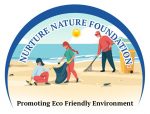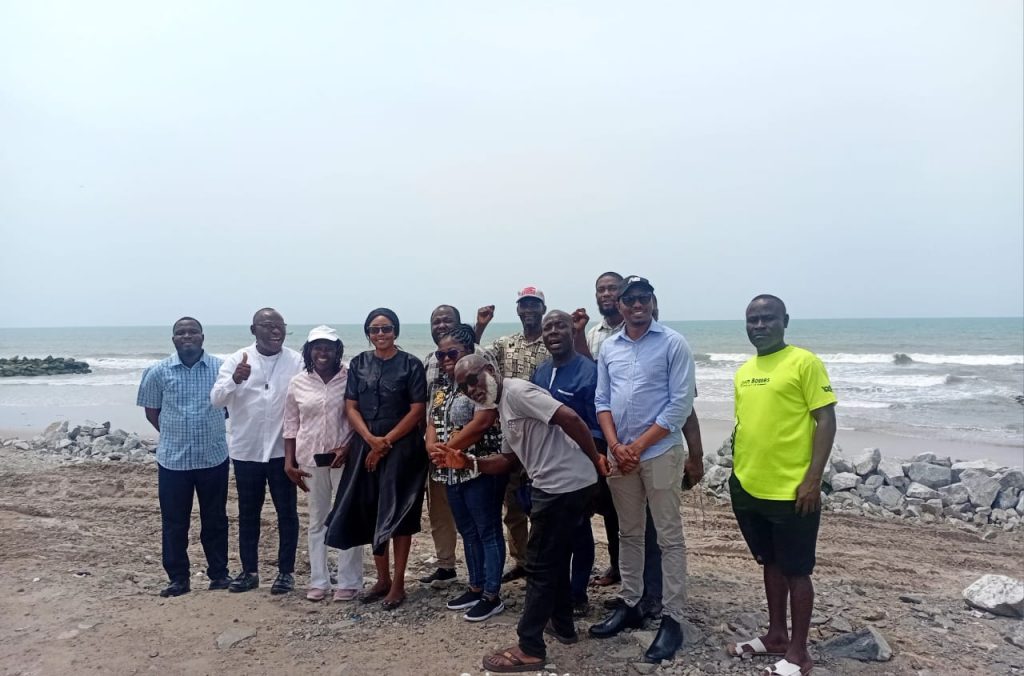The West Africa Coastal Areas (WACA) project sites in Greater Accra notably Shaibu in the Ablekuma West Municipal Assembly and Jamestown in the jurisdiction of Accra Metropolitan Assembly was visited by a team from Ministry of Science and Technology (MEST), World Bank, Civil Society Organizations (CSOs) and the District Assemblies on 16th April, 2025.
The MEST team was led by Dr. Memuna Mattah and the World Bank team was headed by Mr. Raymond Kirwa whilst Mr. Peter Asiedu the Executive Director of Nurture Nature Foundation (NNF) together with Mrs. Vida Akekodaga the Chief Executive Officer of Fill the gap Africa (FTGA) represented the CSOs under Coastal CSOs Forum (CCF) in conjunction with Hon. Daniel Tagoe the Assembly Member of Shaibu Electoral Area representing the District Assembly.
CONCERNS AT SHAIBU
At Shaibu, the team major concern was to analysis the current community landscape as a result of coastal erosion causing damage to buildings and the main road. Mr. Raymond Kirwa asked of the local or community stakeholders’ involvement in WACA project, which Mr.Daniel Nortey of MEST in response addressed that there is 135 community committee members in all the designated project areas whose responsibilities among others is monitoring of all activities and giving feedback to CCF Coordinator.
Mr. Raymond Kirwa further asked about the structure of the community committees and whether it was based on family and friends, for the answer, Hon. Daniel Tagoe, said that he played an instrumental role in the community committee membership selection with fairness and general acceptance by the community leaders. Adding to that Mr. Peter Asiedu indicated that persons with disability are represented on every community committee to promote all-inclusiveness in the community committee, which was applauded by Mrs. Sarah Boasiako a member of the World Bank team.
Mrs. Sarah Boasiako asked whether the community committee have an office they operate from, which Mr. Peter Asiedu answered that District Assemblies are part of the stakeholders which allow the community committee members space when needed for activities.
Mr. George Mawuli a community committee member asked whether the construction of the ongoing groynes, is part of the WACA project, which Mr. Daniel Nortey replied it was not part of WACA project, rather it was initiated by the previous government to check the devastating coastal erosion affecting the livelihoods of the community dwellers.
Comparing the groynes at Glefe to that currently at Shaibu, Mr. David Addoquaye who was part of the attendees said that of Glefe is much fortified and has withstand the test of time, but he wonders if same can be the case at Shaibu, in his reply Mr. Daniel Nortey said all the needful assessment will be carried out by consultants to ensure sustainability of the intervention to prevent future coastal erosion to save the landscape.
Mrs. Sarah Boasiako asked whether there is a concept note for the training of community committee members on grievances redress resolution, which Mr. Daniel Nortey replied in the affirmative, adding that such training will be organized for both Volta and Greater Accra region teams in different clusters for a period of one week, she thus requested for a copy for the World Bank team.
The duration of the WACA project span was also a major concern by Mr. Nii Aflah who is part of the attendees’ to assure the completion of the groynes, in response Mr. Daniel Nortey replied that it will done by Ghana Hydrological Authority within the time scheduled for their mandate.
CONCERNS AT JAMESTOWN
At Jamestown, the team major concern was the issue of waste deposit at the shore although there is much evidence of coastal erosion effect causing damage to culverts along the estuary bridge, make shift structures along the shore which is eroding towards the main road.
The head of World Bank team was so amazed of the waste predicament at the shore which is mainly composed of insulators, coconuts shells and broken food packages. However a careful observation of the waste deposit shows absolutely collection of waste plastics bottles and sachet rubbers, which is clearly positive of segregation of waste to added value on plastics.
The first question asked by Mr. Raymond Kirwa was why the shore is covered with such avalanche of waste, in response Mr. Maxwell Adjei a member of the community committee explained that the Korle lagoon is a carriage route for waste from the inland drainages which is emptied into the sea. He also stated that all the dwellers in the make shift structures along the coast deposit their waste at the shore as payment of the waste deposit charges is a challenge for most of them. In addition he said the skip bin provided is inadequate and easily get filled up leaving room for no choice than to dump the waste generated to the shore or into the sea by the coastal dwellers.
Below is the summary outcome of the meeting when Mr. Raymond Kirwa asked what can be done to prevent the waste from entering the sea, which Mr. Peter Asiedu responded with mutual consensus with MEST team and community committee members.
® The installation of fortified litter trap to withstand the high volume of water pressure from inland through the Korle lagoon estuary into the sea.
® District Assemblies in the catchment jurisdiction of the Korle lagoon must redesign drainages which can prevent waste from entering into the Korle lagoon.
® National policy for waste segregation law to ensure segregation of waste at source, which will allow Bola taxis and skip bin trucks to have different sacks to separate waste collections from source before disposal at the dump site, which Mrs. Sarah Boasiako commended the Bola taxis persistence in using different sacks for waste such as plastics, paper and cans however she insisted the skip bin trucks need to emulate equally.
® MEST to foster sustainable support for CSOs in coastal management to engage in regular coastal cleaning campaigns.
® The WACA team to provide periodic report in all designated areas to access the success of the project.
REPORT BY: PETER ASIEDU
EXECUTIVE DIRECTOR OF NURTURE NATURE FOUNDATION.
REPORT BY PETER ASIEDU – EXECUTIVE DIRECTOR OF NURTURE NATURE FOUNDATION

